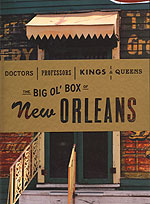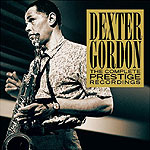
Box sets for jazz, blues fans
|
These reviews first appeared in the Autumn 2004 issue of Turbula.
The holidays each year bring a spate of new box set releases, and for 2004 jazz and blues fans are doubly treated with one set focusing on jazz great Dexter Gordon and another taking in the riches of New Orleans.
No American city has had as profound an impact on popular music as New Orleans. Heck, outside of maybe Havana and perhaps Vienna 200 years ago, it's hard to think of any city that's produced so much great music as the Crescent City. Jazz was born here, the blues percolating alongside, and if Cajun and zydeco developed elsewhere in Louisiana, New Orleans was close enough that plenty of both found their way to town.
"Doctors, Professors, Kings & Queens" explores the full, rich history of New Orleans' musicmaking. From the earliest jazz of Jelly Roll Morton and Louis Armstrong through the rhythm and blues of Johnny Adams and gospel of Irma Thomas to the blues of Marcia Ball and the funk of the Meters, this four-disc set is an uncommonly accurate and comprehensive overview of New Orleans' musical history.
Consider just the hits: Ernie K-Doe's "Mother-in-Law," Aaron Neville's "Tell It Like it Is," Smiley Lewis' "I Hear You Knockin' ." Heck, even Little Richard (from Macon, Ga.) came to town to record at the height of his popularity, and none other than Hank Williams himself wrote the city's unofficial theme song, "Jambalaya."
And all the great characters that have come from N'ahlins through the years, from Louis Armstrong to Professor Longhair (and even Little Richard couldn't play as much piano as 'Fess) to Champion Jack Dupree (who could push 'Fess further than anyone else on the 88s).
Complaints? Well, Harry Connick Jr. and Al Hirt are two of the town's biggest and well-known names outside of Armstrong and the Marsalis clan, yet neither is included here (and Connick is on Sony, which issued this compilation, so what's up with that?).
But that's offset by the unexpected delights – a New Orleans klezmer band, for instance. Or the many tracks from contemporary bands that no one but a local would know, but that still grab your ear and show that the city continues to create fantastic new music (as with a very hip rap cover of "When the Saints Go Marching In").
And then there's the packaging – which is imaginative and fun. Rather than the typical track-by-track analysis or explanation, there are guides to New Orleans bars and restaurants, historic maps of the French Quarter, a look at Mardi Gras (of course!) and another at traditional New Orleans street funerals.
It all combines for a celebration of America's musical capital that is worth of the city that honors.
~ ~ ~
That Dexter Gordon is not as well-known to the general public as contemporaries such as Dizzy Gillespie or John Coltrane is surely criminal. For if Gordon was not at the level of innovator and influence of a Miles Davis or Charlie Parker, he was certainly in the very next tier, alongside such better-known players as Gillespie and 'Trane.
Jazzheads know Gordon, of course – and others remember him for his acting performance in "Round Midnight," the 1986 French ode to American jazz. And there is a new box set from Prestige/Fantasy that will appeal to the jazzheads. "The Complete Prestige Recordings" focuses on Gordon's sessions for Prestige from the early 1960s (a set he did for Jazzland as a guest artist) through the early 1970s (when he recorded exclusively for Prestige), easily Gordon's artistic peak. While he recorded for other labels during this period (particularly for Blue Note, where some of his best work was done in the early to mid-1960s), his Prestige sides are generally as good as his other sessions.
This 11-disc set is an impressive collection, capturing Gordon in a variety of settings – small combo and large, studio dates and live. The heart of this set is the series of albums he recorded for Prestige from 1969-'73. But the collection is also fleshed out with tracks in which Gordon was a guest artist on sets by Booker Ervin and Wardell Gray.
His playing throughout shows a confident, muscular saxophonist, a man who played with much the same imaginative abandon and raw athleticism as Sonny Rollins. But where Rollins' solos tend to be more linear and narrative in flow, Gordon's are more impressionistic and hopscotch.
Regardless, in the absence of a Blue Note box set, fans of Gordon's gorgeous tone and endless imagination may want to add this set to their collection this year.

